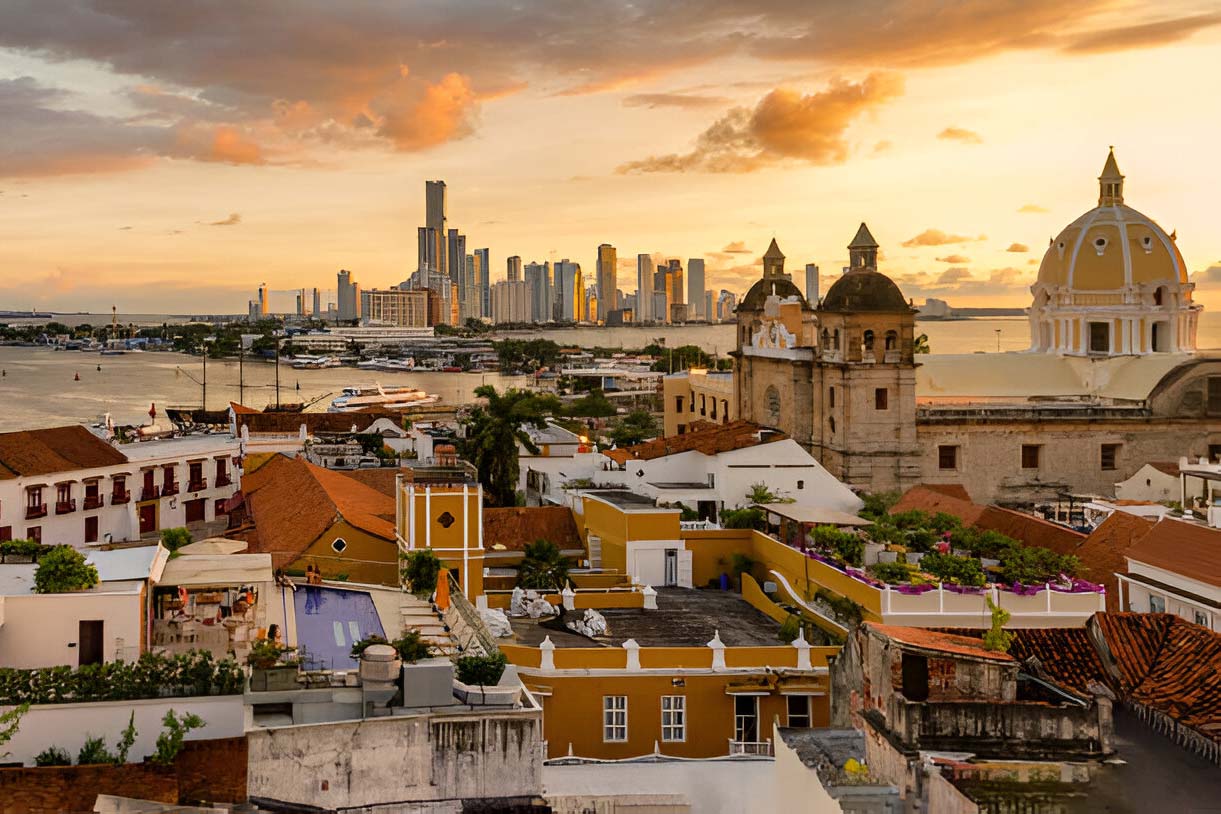Embarking on a journey from the coastal beauty of Cartagena to the large city of Medellín offers a glimpse into the diverse landscapes and cultures of Colombia. As you leave behind the historic charm of Cartagena’s colonial architecture and pristine beaches, you venture into the heart of the Andes, where Medellín awaits with its modern skyline, lush green hills, and dynamic cultural scene.
Whether you’re traveling by bus, car, or plane, this trip is an unforgettable adventure filled with breathtaking views, rich history, and the warmth of Colombian hospitality. Join us as we share the exhaustive highlights, hidden gems, and personal experiences from an unforgettable journey between these two incredible cities.
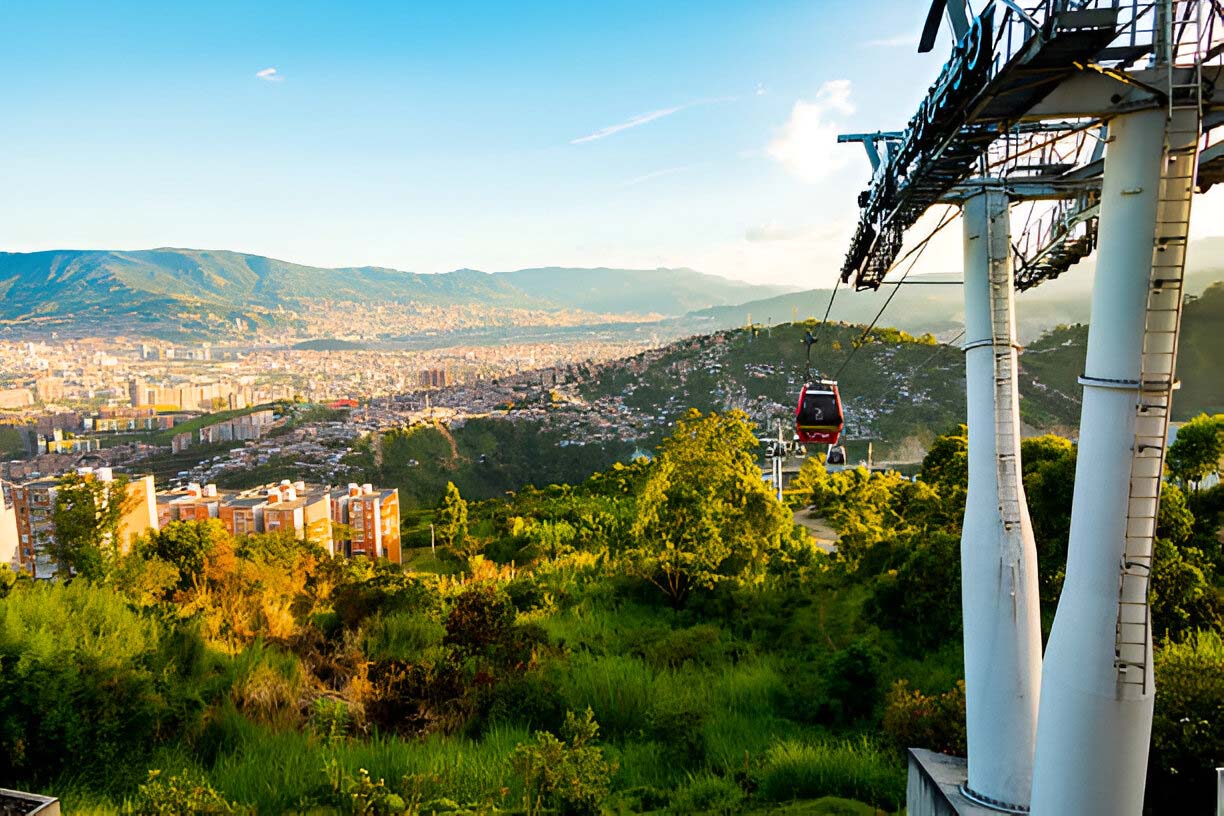
Planning Your Trip From Cartagena to Medellin
Planning a trip from the historic coastal city of Cartagena to the vibrant metropolis of Medellin? Whether you’re a seasoned traveler or embarking on your first Colombian adventure, navigating this journey can be both thrilling and challenging.
From choosing the best mode of transport to uncovering hidden gems along the way, our comprehensive guide is designed to ensure your trip is as smooth and enjoyable as possible. Join us as we delve into essential tips, insider advice, and must-see attractions that will transform your travel experience into an unforgettable journey. Pack minimal essentials, including interchangeable outfits, basic necessities, and a few items, to travel light and hassle-free.
Get ready to explore Colombia like never before.
Brief Overview of the Journey
Traveling between these two cities takes you on an exciting journey between two of Colombia’s most captivating cities. Cartagena, with its colonial charm, vibrant Caribbean culture, and stunning coastal views, offers a stark yet thrilling contrast to Medellin, known for its innovation, mountainous landscapes, and bustling urban life. This journey offers a glimpse into the diverse landscapes and cultures of South America.
The distance between each city is approximately 640 kilometers (400 miles), and the journey can be undertaken by air, bus, or car, each offering its unique experiences. Flying is the quickest and most convenient option, with several daily direct flights connecting Rafael Núñez International Airport in Cartagena to José María Córdova International Airport in Medellin, taking around 1.5 hours.
For those who prefer ground travel, buses provide an affordable and scenic alternative, allowing you to witness the diverse landscapes of Colombia, from the lush coastal plains to the rugged Andean mountains. The bus journey typically takes around 12 to 14 hours, depending on the route and traffic conditions.
Driving offers the most flexibility, enabling you to explore hidden gems and quaint towns along the way. However, it requires careful planning and consideration of road conditions and safety.
No matter how you choose to travel, moving from the historic allure of Cartagena to the dynamic vibrancy of Medellin promises a rich tapestry of experiences, showcasing the diverse beauty and culture that Colombia has to offer.
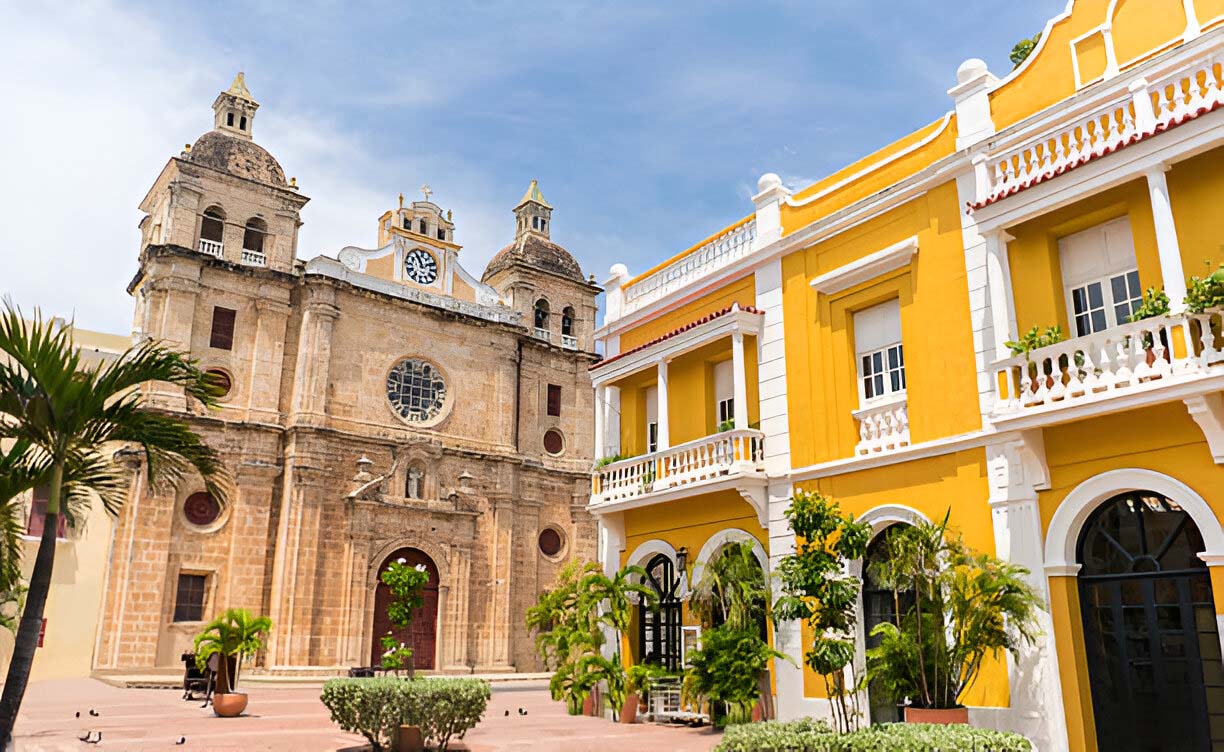
Why Cartagena?
Cartagena: Architecture, History, and High-End Dining
Cartagena, a jewel on Colombia’s Caribbean coast, enchants visitors with its rich history, vibrant culture, and stunning seaside scenery. Known for its well-preserved colonial architecture and colorful streets, the city’s historic walled center, a UNESCO World Heritage site, is a testament to its storied past. Wander through the cobblestone streets, explore centuries-old forts, and soak in the beauty of colonial-era buildings, each telling tales of a bygone era.
The city’s cultural vibrancy extends beyond its architecture. Cartagena is alive with music, dance, and festivals. The annual Hay Festival and Cartagena International Music Festival draw artists and audiences from around the world, while the lively nightlife, with its salsa clubs and beachfront bars, ensures that there’s always something happening after dark. The local cuisine, heavily influenced by African, Spanish, and Indigenous flavors, is a culinary adventure. Savoring dishes like ceviche, arepas, and fresh seafood is a must.
Beyond the city’s historical and cultural allure, Cartagena’s natural beauty is equally captivating. The nearby Rosario Islands offer crystal-clear waters and pristine beaches, perfect for a day of relaxation or water sports. The city’s tropical climate and coastal location make it a year-round destination.
Moreover, the warmth and friendliness of the Cartageneros, the local people, add to the city’s welcoming atmosphere. In Cartagena, history, culture, and natural beauty come together to create a truly unforgettable destination.
Why Medellín?
Medellín: The Country’s Most Innovative City and The City of Eternal Spring
Medellín captivates visitors with its perfect climate, innovative spirit, and vibrant culture. Nestled in the Aburrá Valley and surrounded by the Andes mountains, the city enjoys a year-round temperate climate.
Medellín’s transformation from a troubled past to a beacon of progress earned it the title of the world’s most innovative city by the Wall Street Journal. Its extensive metro and cable car system, as well as the rejuvenation of public spaces, highlight the city’s commitment to inclusivity and sustainability.
The cultural scene in Medellín is dynamic, featuring museums, galleries, and public art installations like the Museum of Antioquia and Botero Plaza. Annual events such as the Flower Festival and the Medellín International Poetry Festival showcase local traditions.
Food enthusiasts will relish the city’s diverse dining options, from traditional Colombian cuisine to international fare. Nature lovers can enjoy outdoor activities in the nearby hills and the Arví Park.
Above all, the warmth and hospitality of the Paisas make Medellín an unforgettable destination, blending innovation, culture, and natural beauty.
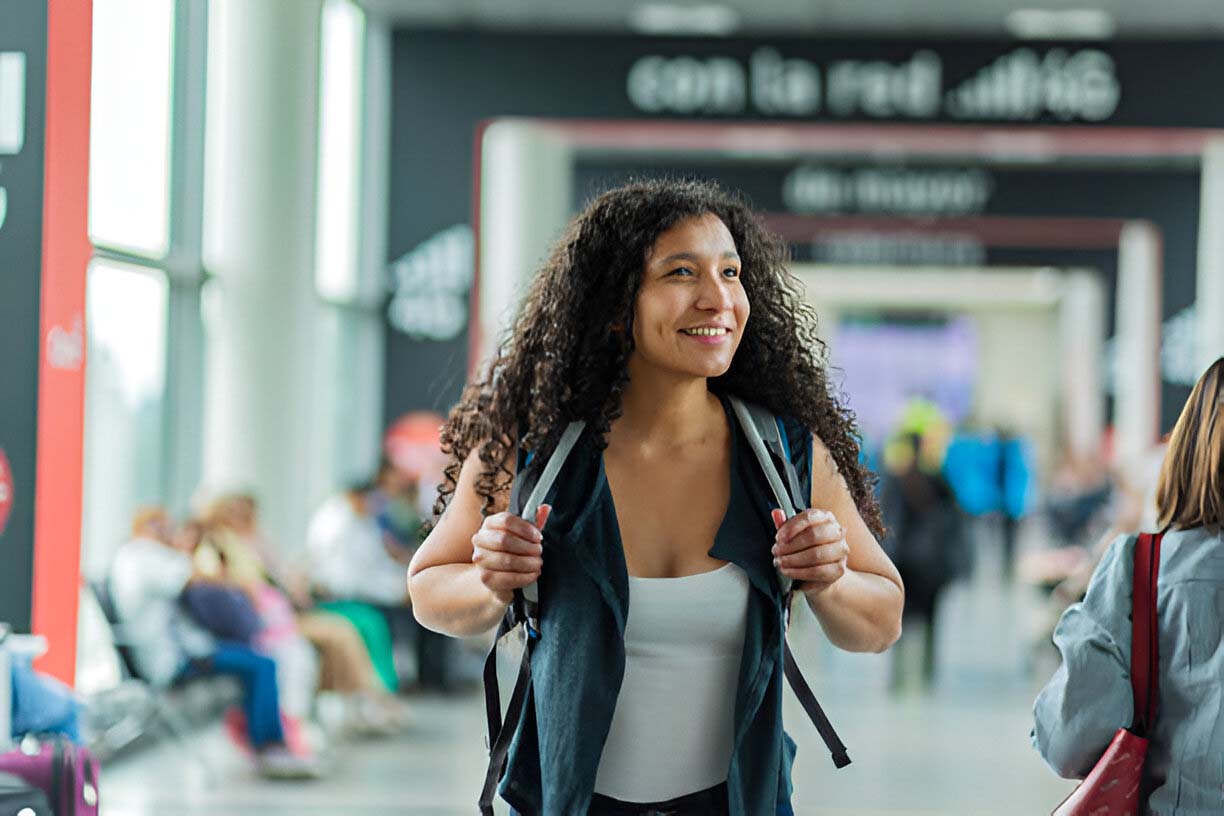
Preparing for Your Journey
Choosing Your Mode of Transport: Flights vs. Buses
The two primary options are flying or taking a bus. Each mode of transport has its own set of advantages and disadvantages, depending on your preferences, budget, and time constraints. In this comparative piece, we’ll explore both options to help you make an informed decision.
Flights: Quick and Convenient
Advantages:
Speed: Flying is by far the fastest way to travel between Cartagena and Medellin. The flight duration is approximately 1.5 hours, compared to the 12-14 hour bus journey. If you’re short on time or simply prefer to spend more of your trip exploring rather than traveling, flying is the clear choice.
Comfort: Air travel offers a higher level of comfort, with modern amenities such as in-flight entertainment, food and beverage services, and more spacious seating. Additionally, the shorter travel time means less fatigue.
Frequency: There are numerous daily flights between Cartagena and Medellin, provided by several airlines. This gives you flexibility in choosing a departure time that fits your schedule.
Disadvantages:
Cost: Flights are generally more expensive than bus tickets. While there are budget airlines and occasional deals, the overall cost can still be a significant factor for travelers on a tight budget.
Airport Hassles: Air travel involves additional time for check-in, security checks, and potential delays. Getting to and from the airport can also be time-consuming and may incur extra costs.
Buses: Economical and Scenic
Advantages:
Cost: Buses are typically much cheaper than flights, making them a great option for budget-conscious travelers. The savings can be significant, especially if booked in advance or during off-peak times.
Scenic Route: Traveling by bus allows you to see more of Colombia’s beautiful landscapes. The journey takes you through diverse regions, offering a glimpse of the country’s natural beauty and rural life that you would miss by flying.
Flexible Luggage Policies: Buses often have more lenient luggage policies compared to airlines. You can bring more bags without worrying about extra fees.
Disadvantages:
Travel Time: The bus journey can take anywhere from 12 to 14 hours. This is a considerable time commitment, and the long trip can be tiring.
Comfort: While many long-distance buses in Colombia are equipped with reclining seats, air conditioning, and entertainment systems, they still can’t match the comfort level of a flight. The extended duration of the trip can be uncomfortable, especially for those not accustomed to long bus rides.
Fewer Options: Bus services between Cartagena and Medellin are less frequent than flights. This means you have fewer choices in terms of departure times, which might limit your scheduling flexibility.
Making the Decision
When to Choose a Flight:
— If you have limited time and need to reach your destination quickly.
— If comfort and convenience are top priorities.
— If you don’t mind spending more for a faster, more comfortable journey.
When to Choose a Bus:
— If you’re traveling on a budget and want to save money.
— If you enjoy scenic routes and are interested in seeing more of the countryside.
— If you prefer a more relaxed travel experience and don’t mind the longer journey.
Language and Currency
Learning Spanish Basics
Traveling through Colombia is a fantastic opportunity to immerse yourself in the local culture, and learning some basic Spanish can significantly enhance your experience.
While many locals in Medellín speak some English, learning basic Spanish phrases will enhance your experience.Take the time to learn essential phrases like “¿Cuánto cuesta?” (How much does it cost?), ¿dónde está…?” (where is…?), and “gracias” (thank you).
Colombians are known for their warmth and hospitality, and making the effort to speak Spanish often results in a more authentic and enriching travel experience, plus having a grasp of basic Spanish can boost your confidence when traveling. You’ll feel more self-assured when negotiating prices and asking for help.
Using the Colombian Peso
The Colombian Peso is the local currency, and you can exchange your money at a currency exchange office or withdraw from an ATM. Credit cards are widely accepted in Medellín, but it’s always a good idea to have some cash on hand.
Packing Essentials: What to Bring for the Journey
When preparing for your trip, packing smartly can make your journey much more comfortable and enjoyable. Start with the basics: lightweight, breathable clothing is essential for Cartagena’s tropical climate, but don’t forget to pack a few layers for the cooler, mountainous climate of Medellin. A good pair of walking shoes is indispensable, as both cities are best explored on foot.
Since you’ll be on the move, consider bringing a small, versatile backpack to carry daily necessities such as a water bottle, snacks, sunscreen, and a hat. Given the length of the bus ride, if you choose that mode of transport, having a travel pillow, earplugs, and an eye mask can make the trip more bearable. An e-reader or a good book, headphones, and a power bank will keep you entertained and ensure your devices stay charged.
Don’t forget your essential toiletries, but remember that many items can be purchased locally if needed. A basic first-aid kit with band-aids, pain relievers, and any personal medications is always a good idea. Copies of important documents such as your passport, travel insurance, and tickets should be packed in both physical and digital forms for safety.
Lastly, packing light will make your travels easier, especially if you need to navigate through airports, bus stations, and city streets. Bring only a few items: minimal essentials like interchangeable outfits, basic necessities, and a few other items to keep your luggage manageable.
By bringing only what you need and thinking ahead about the different climates and activities you’ll encounter, you’ll be well-prepared for a smooth and enjoyable journey.
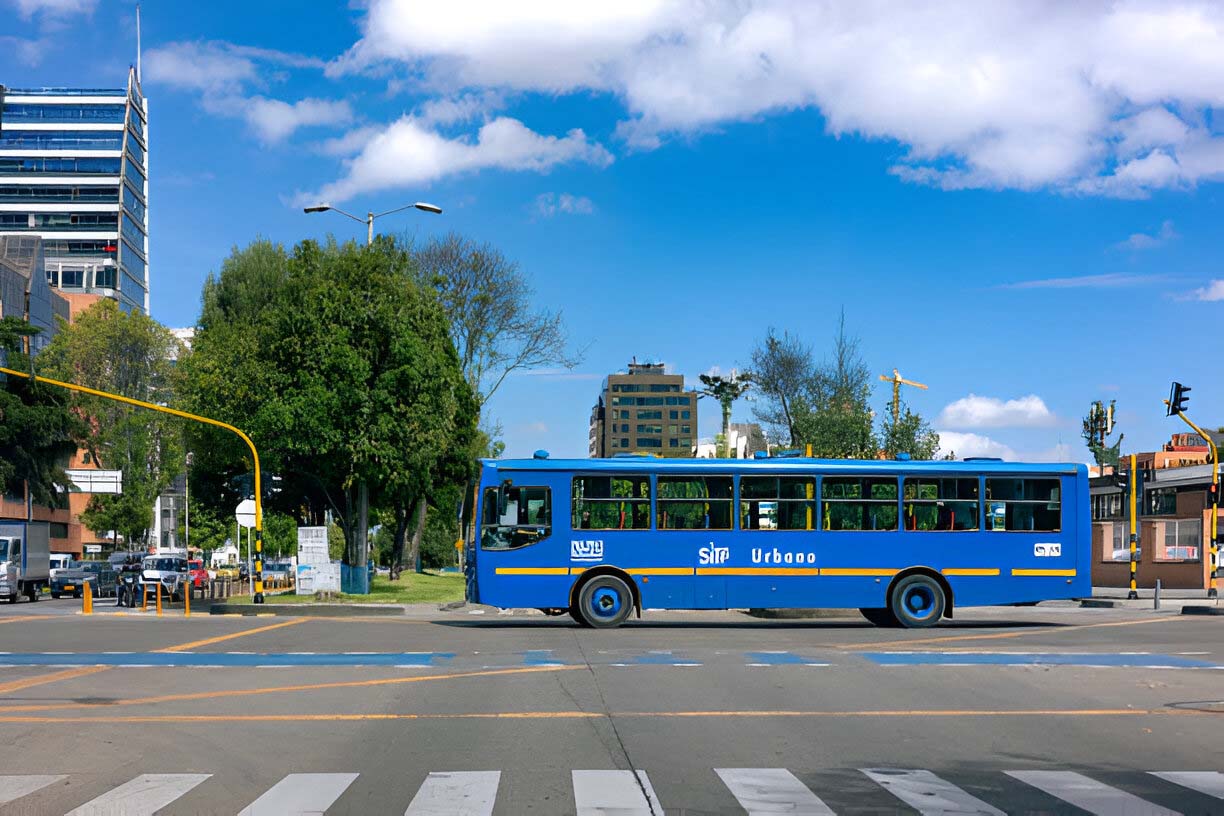
On the Road: Highlights of a Bus Journey from Cartagena to Medellin
Traveling by bus offers a unique and immersive way to experience the diverse landscapes of Colombia. As you leave the coastal city of Cartagena, you’ll first pass through lush tropical regions, where you can see palm trees, vibrant flowers, and occasionally glimpse the Caribbean Sea. The scenery gradually changes as you move inland, showcasing the rich agricultural areas where local farmers cultivate crops like bananas, Colombian coffee, and cocoa.
One of the most remarkable parts of the journey is crossing the Magdalena River, Colombia’s longest and most significant river. This crossing often provides stunning views of the river’s expanse and the surrounding greenery. As the bus continues its route, you’ll begin to notice a shift in terrain as you approach the Andes mountains. The climb into the mountains brings breathtaking views of valleys, forests, and winding rivers.
The journey also offers a glimpse into rural Colombian life. You’ll pass through small towns and villages where you can observe traditional Colombian architecture, local markets, and everyday life that remains largely untouched by the hustle and bustle of larger cities. Many attractions in these small towns are within walking distance, making it easy to explore. These towns often have charming roadside eateries where the bus might stop, allowing you to try regional snacks and beverages.
As you get closer to Medellin, the road will take you through dramatic mountain landscapes with steep cliffs and deep gorges. The final approach to the city offers panoramic views of Medellin nestled in the Aburrá Valley, surrounded by lush green mountains. The contrast between the natural beauty of the landscape and the modern skyline of Medellin is striking and provides a memorable conclusion to your bus journey.
Overall, the bus trip is not just a means of transportation but an opportunity to witness the rich geographical and cultural tapestry of Colombia. The changing landscapes, the glimpse into rural life, and the impressive mountain scenery all contribute to making this journey a highlight of your travels.
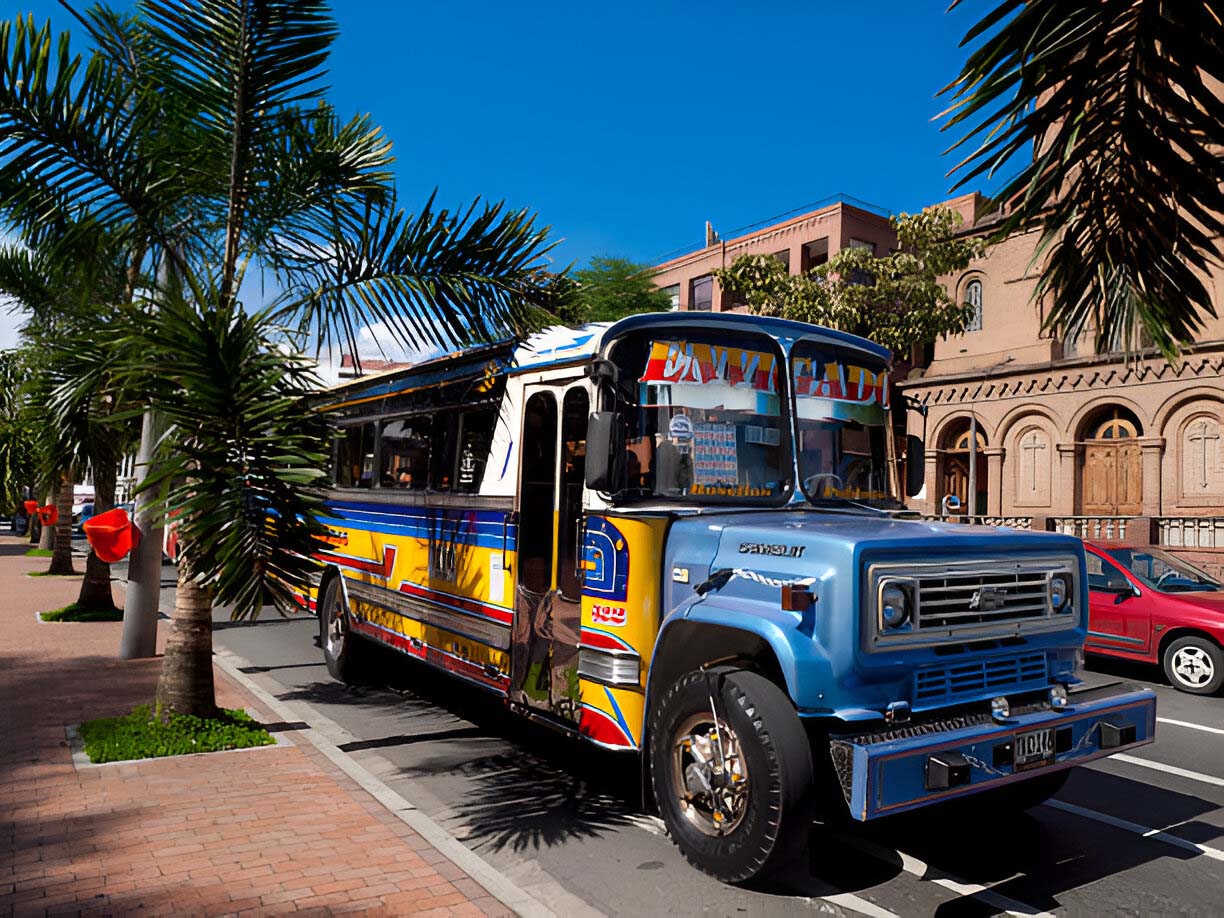
Arrival in Medellin: First Impressions and Practical Tips
Arriving in Medellin, you’ll immediately notice the city’s dynamic energy and stunning natural setting. Nestled in the Aburrá Valley, Medellin’s skyline is framed by lush, green mountains, creating a picturesque and inviting first impression. The weather, often described as “eternal, spring like weather,” is typically mild and pleasant, which adds to the city’s welcoming atmosphere.
As you make your way from the transport hub—whether it’s the José María Córdova International Airport or one of the city’s bus terminals—take a moment to appreciate the vibrant street life. Medellin is known for its bustling markets, colorful street art, and friendly locals, known as “Paisas.” The city’s efficient metro system is a great way to get around; it’s clean, safe, and offers a quick introduction to the city’s layout. Additionally, the city boasts a thriving cafe culture with a ton of coffee shops where you can enjoy a variety of brewing methods and beans.
One of the first practical tips is to get a Metro card, which you can purchase and recharge at any metro station. This card will be invaluable for traveling around the city. Taxis and ride-sharing services like Uber are also widely available and are a convenient option for getting to your accommodation, especially if you’re carrying luggage.
When it comes to accommodation, Medellin offers a wide range of options, from budget hostels in the lively El Poblado neighborhood to upscale hotels and charming boutique guesthouses. El Poblado is particularly popular among travelers for its nightlife, restaurants, and proximity to major attractions, though areas like Laureles also offer a more local experience with plenty of dining and entertainment options.
It’s wise to have some Colombian pesos on hand upon arrival, as cash is often preferred in smaller establishments and markets. ATMs are plentiful throughout the city, and it’s generally safe to use them, especially those located inside banks or shopping centers.
For your first meal in Medellin, consider trying a traditional dish like “bandeja paisa,” a hearty platter that includes beans, rice, meat, avocado, plantains, and a fried egg. It’s a perfect way to dive into the local cuisine and fuel up after your journey.
Accommodation in Medellín
Neighborhoods to Consider
When choosing where to stay, it’s essential to consider the vibe and amenities of different neighborhoods to find the perfect fit for when you visit Medellín.
Each area offers a unique experience, catering to diverse preferences and budgets. Here’s a look at some of the most popular to consider:
El Poblado: A Popular Choice: El Poblado is undoubtedly the most well-known neighborhood among tourists and expatriates. It’s a bustling area filled with high-end restaurants, chic cafes, trendy bars, and vibrant nightlife.
Parque Lleras, the heart of El Poblado, is a hotspot for social activities, attracting both locals and visitors, including expats and digital nomads. The neighborhood also boasts a range of accommodation options, from luxurious hotels to affordable hostels, making it suitable for all types of travelers.
The convenience of nearby shopping centers like Santa Fe and El Tesoro adds to its appeal. While El Poblado is slightly more expensive than other areas, its lively atmosphere and modern amenities make it a top choice for many.
Laureles: A Local Favorite: For a more local and laid-back experience, consider staying in Laureles. This residential neighborhood is known for its tree-lined streets, charming parks, and a relaxed atmosphere.
Laureles is home to numerous cafes, bakeries, and traditional Colombian restaurants, offering a taste of local life. The area around La 70 (Setenta) is particularly popular for its nightlife, with many bars and live music venues.
Accommodations in Laureles tend to be more affordable than in El Poblado, and you’ll find a good mix of boutique hotels, guesthouses, and budget-friendly options. It’s also conveniently located near the Estadio metro station, providing easy access to the rest of the city.
Envigado and Sabaneta: Affordable Options: If you prefer a quieter, suburban experience, Envigado and Sabaneta are excellent choices. These neighborhoods are both strategically located, just south of Medellín and offer a more relaxed pace of life.
Envigado, known for its friendly community and traditional charm, features lovely parks, local markets, and excellent dining options, including authentic Colombian eateries. Sabaneta, further south, has a small-town feel with a strong sense of community and beautiful public spaces.
Both areas offer a range of accommodations, from modern apartments to cozy guesthouses, and are well-connected to Medellín via the metro. Staying here provides a more authentic experience of daily life in the Medellín metropolitan area.
El Centro/La Candelaria, the Heart of the City: For those interested in history and culture, El Centro (also known as La Candelaria) is the place to be. This is the historic heart of Medellín, where you’ll find many of the city’s main attractions, including Plaza Botero, the Museum of Antioquia, and the Metropolitan Cathedral.
El Centro is bustling with activity during the day, with street hawkers, markets, and cultural sites. Accommodations here are generally more affordable, including budget hotels and hostels. El Centro/La Candelaria is also home to many galleries showcasing works by artists.
However, it’s worth noting that El Centro can be less safe at night compared to other neighborhoods, so it’s important to stay vigilant and choose lodging in well-reviewed and secure establishments.
Is Medellín Safe?. From One of the Most Dangerous Cities to a Safe Haven
Like Mexico City, Medellín, once infamous for its high crime rates and turbulent past, has undergone a remarkable transformation over the past few decades. Known in the 1980s and 1990s as one of the most dangerous cities in the world, a violent city largely due to the influence of notorious drug traffickers and cartels, Medellín has reinvented itself as a vibrant, innovative, and welcoming metropolis.
Today, it is celebrated for its urban development, cultural renaissance, and improved safety, attracting tourists and expatriates from around the globe. While the city is much safer than it used to be, understanding the local landscape and taking sensible precautions can help ensure a safe and enjoyable visit for expats and tourists alike; as is the case around the world, pick pocketing, petty crime and drug dealers can still be found.
Be Aware of Your Surroundings
Staying vigilant and aware of your surroundings is crucial for ensuring your safety while exploring Medellín. As in any major city, being mindful of your environment can help you avoid potential risks and fully enjoy your time in this vibrant metropolis.
Pay attention to the people around you, especially in crowded places like public transportation, markets, and popular tourist spots. Keep your belongings secure and avoid displaying valuables such as expensive jewelry, cameras, or large amounts of cash. Trust your instincts; if a situation or area feels unsafe, it’s best to move to a more populated or familiar place.
By staying alert and using common sense, you can confidently navigate Medellín and make the most of your visit.
Getting Around Medellín
Exploring on Foot. What’s in Walking Distance?
Medellín is a walkable city, and exploring on foot is a great way to discover its hidden gems. Take a stroll through downtown Medellín and explore the many parks and plazas.
Taxis and Ride-Hailing
Taxis and ride-hailing services like Uber are widely available in Medellín. Make sure to use licensed taxi drivers or ride-hailing services to ensure your safety.
Medellín’s Metro and Cable Car System
Medellín has a comprehensive metro and cable car system that makes it easy to get around the city. The system is efficient and affordable, making it a great way to explore Medellín. The metro and cable car system provides easy access to the entire city.
Living in Medellín
Cost of Living: Medellín offers an affordable cost of living, making it a popular destination for expats and digital nomads. Rent, food, and low cost of transportation are relatively cheap, making it easy to live comfortably in Medellín.
Lifestyle and Culture: Medellín is known for its vibrant culture, with many festivals and events throughout the year. Embrace the Paisa culture by trying traditional Colombian cuisine, attending local events, and exploring the city’s many museums and galleries. Medellín is also home to many galleries and public art installations showcasing works by local artists.
Medical Care in Medellín: Medellín has top-notch medical facilities, with many hospitals and clinics offering high-quality care. The city is also home to many medical tourism facilities, offering affordable medical procedures.
Museums and Galleries: Medellín has a thriving cultural scene, with many museums and galleries showcasing local and international art. These venues often feature works by local artists, providing a unique glimpse into the city’s vibrant art scene. The city is also home to many festivals and events throughout the year, celebrating music, dance, and art.
Cuisine and Nightlife
Medellín is known for its delicious cuisine, with many traditional dishes like bandeja paisa and fried pork belly. The city also has a vibrant nightlife, with many bars, clubs, and restaurants to choose from. Medellín has many restaurants offering a diverse range of dining experiences, from iconic snacks to fine dining at affordable prices.
Medellín offers a diverse and exciting culinary scene, where traditional Colombian flavors blend seamlessly with international influences. From street food vendors serving arepas and empanadas to upscale restaurants offering innovative dishes, there’s something to satisfy every palate. Don’t miss trying local specialties like bandeja paisa, ajiaco and fried pork belly, and be sure to explore the vibrant nightlife.
Medellín comes alive after dark with lively salsa clubs, chic cocktail bars, and relaxed lounges where you can enjoy the city’s famous hospitality and dance the night away.
Whether you’re craving a taste of Colombia or seeking a memorable night out, Medellín’s cuisine and nightlife won’t disappoint.
Understanding the Local Customs
To truly appreciate Medellín’s rich cultural tapestry, it’s essential to understand and respect local customs. Colombians are known for their warmth and friendliness, so greeting people with a handshake and a smile is customary. Respect for family is deeply ingrained, and you may notice that many activities and social gatherings revolve around family ties. Colombians also take pride in their appearance and dress neatly and conservatively in most situations.
When dining, it’s polite to wait until everyone at the table has been served before beginning your meal, and expressing gratitude with a sincere “gracias” is appreciated. If invited to someone’s home, bringing a small gift such as flowers or chocolates is a thoughtful gesture. Additionally, Colombians often use formal titles like “señor” (Mr.) and “señora” (Mrs.) when addressing older individuals or those in positions of authority, reflecting a respect for hierarchy and age.
For religious customs, many Colombians are Catholic, and religious holidays are widely observed with festivals and celebrations. Taking part in local festivities like the Medellín Flower Festival (Feria de las Flores) or Semana Santa (Holy Week) offers a deeper understanding of the city’s cultural and religious heritage. By embracing these customs with an open mind and heart, you’ll forge meaningful connections and gain a richer appreciation for Medellín’s vibrant culture.
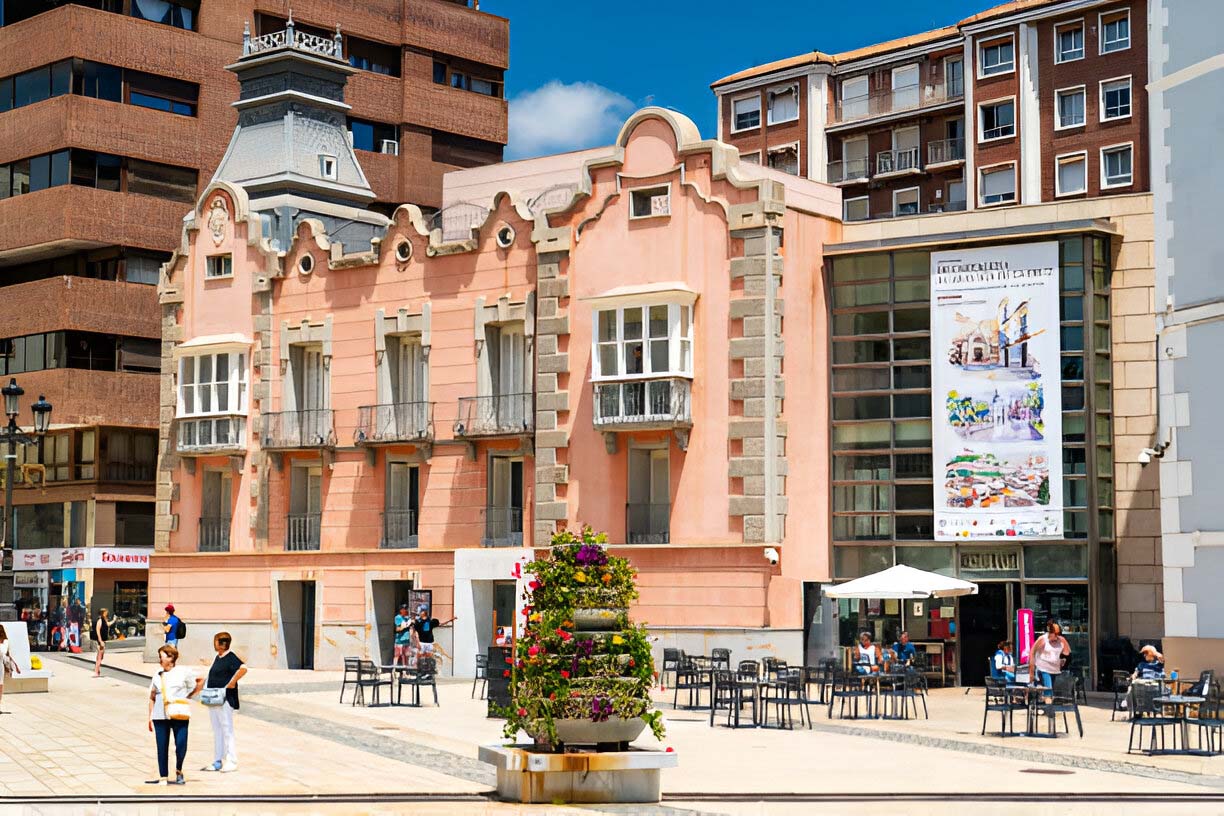
Arrival in Cartagena: First Impressions and Practical Tips
Arriving in Cartagena, you’ll be immediately captivated by the city’s vibrant colors and rich history. Located on Colombia’s Caribbean coast, Cartagena’s skyline features a blend of modern skyscrapers and the historic colonial architecture of the walled city, all set against the backdrop of the sparkling Caribbean Sea. The city’s warm tropical climate greets you with a gentle sea breeze, creating a welcoming and relaxed atmosphere.
Getting Around
Upon arrival at Rafael Núñez International Airport or one of Cartagena’s bus terminals, you’ll notice the city’s lively energy and welcoming people. Cartagena is known for its bustling streets, colorful buildings, and the lively rhythm of Afro-Caribbean music. The city is easy to navigate on foot, especially in the historic center, where you can explore its charming streets and plazas.
For longer distances, taxis and ride-sharing services like Uber are convenient and widely available. Ensure that you agree on a fare or use the meter in taxis to avoid any confusion. Buses and local minibusses, known as “colectivos,” are also an option for getting around, though they can be crowded, especially in rush hour.
Practical Tips
One of the first things you should do is exchange some currency for Colombian pesos. Cash is often preferred in smaller establishments and street markets, although credit cards are accepted in most hotels and larger restaurants. ATMs are readily available, and it’s generally safe to use those located inside banks or shopping centers.
When choosing accommodations, Cartagena offers a range of options to suit any budget. You can stay in a luxurious hotel in the Bocagrande district, with its modern amenities and beach access, or opt for a more intimate experience in a boutique hotel or hostel within the historic walled city. Popular areas for tourists include Getsemaní, known for its artistic vibe and lively nightlife, and San Diego, which offers a more laid-back atmosphere.
Culinary Delights
For your first meal in Cartagena, dive into the local culinary scene with a taste of arepas de huevo or ceviche, which highlight the region’s fresh seafood and Caribbean flavors. The city’s vibrant food scene includes everything from street vendors selling empanadas to upscale restaurants offering gourmet twists on traditional dishes. Don’t miss trying a refreshing limonada de coco (coconut limeade) to cool down in the tropical heat.
As you explore Cartagena, take in the sights and sounds of this enchanting city, where history and modernity blend seamlessly. With its warm climate, friendly locals, and stunning scenery, Cartagena is sure to make a lasting impression.
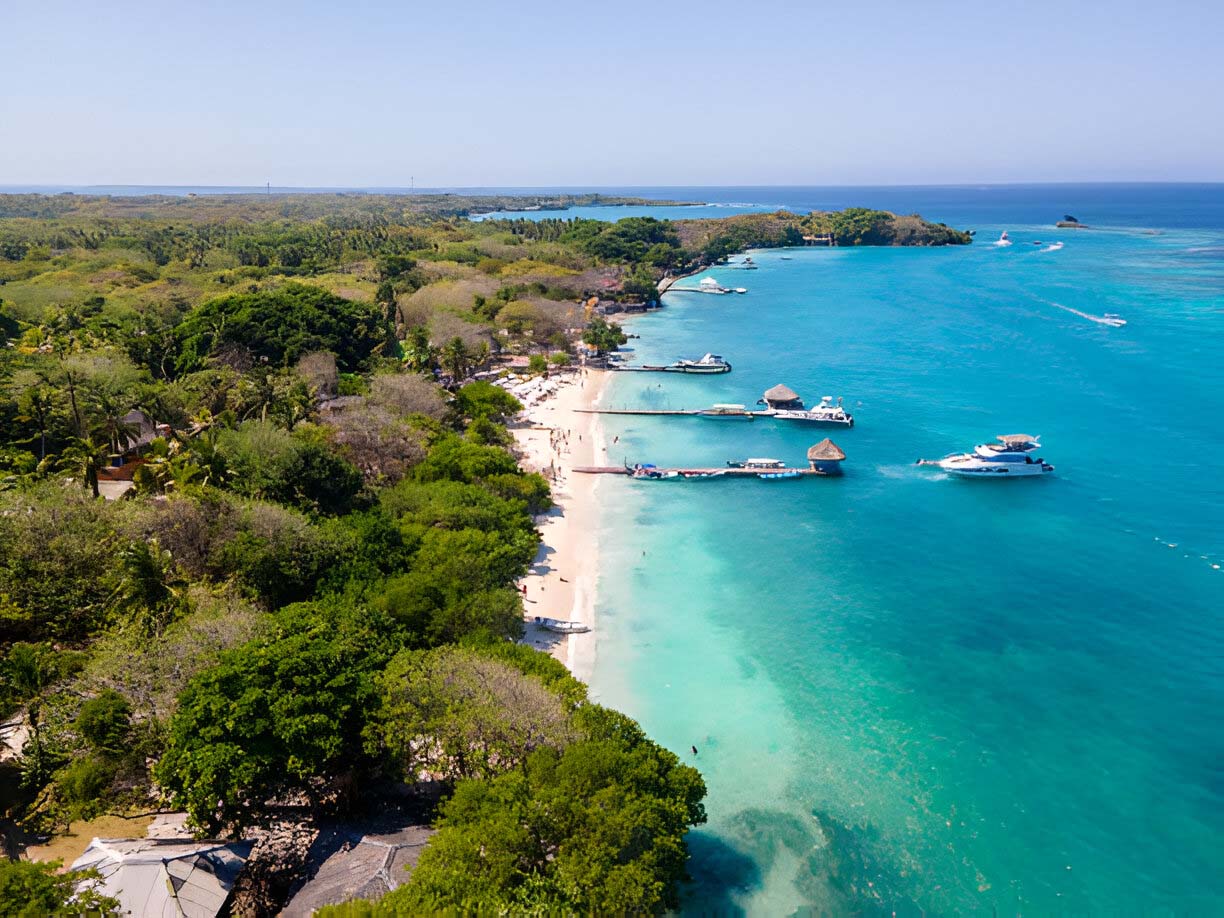
Discovering the Best Beaches in Cartagena
Cartagena, Colombia, is a paradise for beach lovers, offering stunning coastal views and crystal-clear waters. Here are some of the best beaches to visit in and around this vibrant city:
Bocagrande Beach: Located just minutes from the city center, Bocagrande Beach is perfect for those looking to enjoy the sun without straying far from Cartagena’s urban attractions. With its bustling atmosphere, you can enjoy water sports, beachside bars, and a lively nightlife scene.
Playa Blanca: Known for its powdery white sand and turquoise waters, Playa Blanca is a must-visit for those seeking a more tranquil experience. Located on the Isla Barú, this beach is ideal for relaxing, swimming, and snorkeling. It’s a great spot for a day trip, offering breathtaking views and a laid-back vibe.
Rosario Islands: A short boat ride from Cartagena, the Rosario Islands offer some of the most pristine beaches in the area. This archipelago is a protected national park, boasting incredible coral reefs and diverse marine life. Activities such as snorkeling, scuba diving, and kayaking are popular here, providing visitors with unforgettable underwater adventures.
Castillogrande Beach: Located in an upscale neighborhood, Castillogrande Beach is known for its calm waters and serene environment. This beach is ideal for families and those looking to escape the crowds. The area is lined with luxury condos and offers a peaceful setting for sunbathing and leisurely strolls.
Manzanillo del Mar: For a more secluded experience, head to Manzanillo del Mar, located north of the city. This beach offers a quieter atmosphere and a chance to unwind away from the tourist bustle. Enjoy horseback riding along the shore or relax under the shade of palm trees.
Each of these beaches offers a unique slice of Cartagena’s coastal beauty, making the city a perfect destination for beach enthusiasts seeking relaxation and adventure.
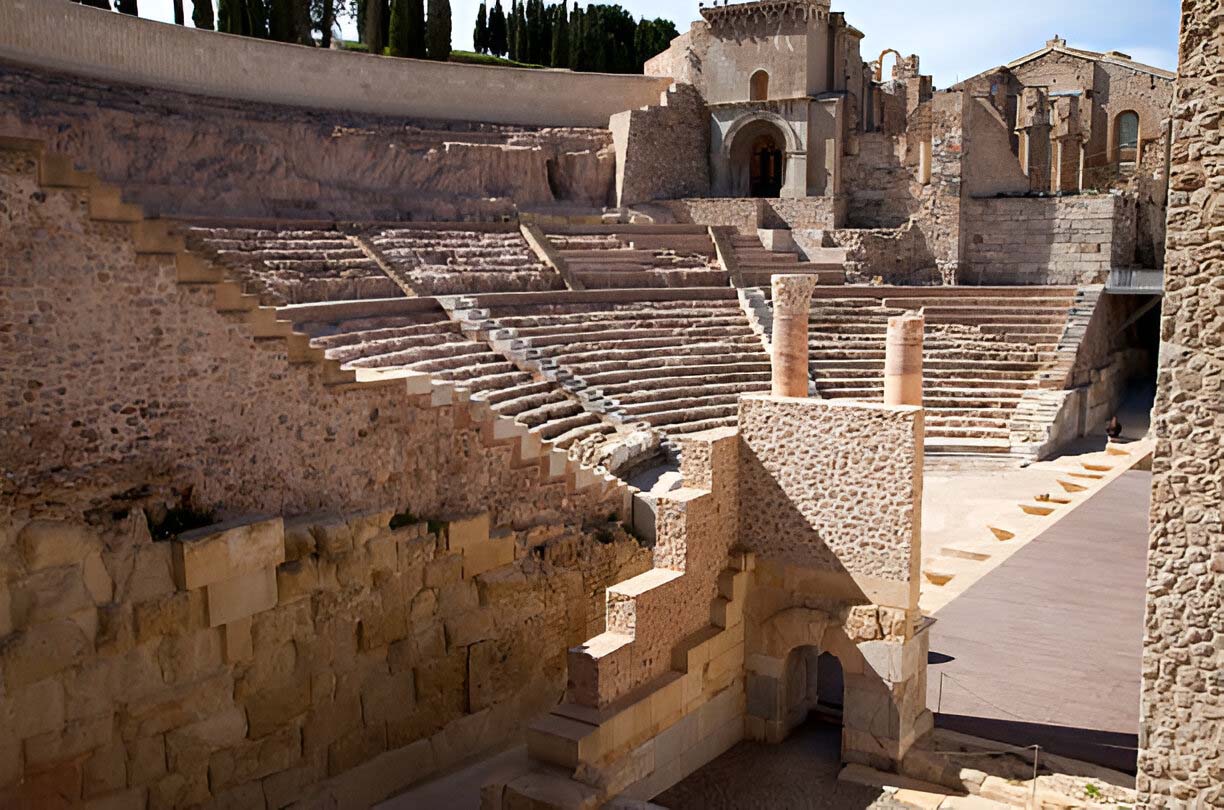
Cultural Contrasts and Similarities Between the Two Cities
Exploring the country reveals distinct cultural nuances and shared traditions that highlight the country’s rich diversity. Both cities reflect the rich cultural diversity of South America.
Historical Influences
Cartagena: Known for its well-preserved colonial architecture and rich Caribbean influence, Cartagena is a city that beautifully reflects a blend of Spanish, African, and indigenous cultures. The historic walled city is a UNESCO World Heritage site, offering a glimpse into its colonial past with cobblestone streets, charming plazas, and stunning cathedrals.
The large city’s vibrant colors, lively music, and delicious coastal cuisine embody its Caribbean heritage, creating a lively and welcoming atmosphere. Visitors can explore its many attractions, such as the imposing Castillo San Felipe de Barajas, or relax on the beautiful beaches of Bocagrande and the Rosario Islands. With its dynamic fusion of history, culture, and natural beauty, Cartagena is a captivating destination.
Medellín: Nestled in the picturesque Andes, Medellín Colombia is a city that offers a fascinating contrast with its urban sophistication and innovative spirit. Once known for its turbulent past, Medellín has transformed into a hub of innovation and culture, earning it the nickname “The City of Eternal Spring” due to its pleasant climate. Influenced by a rich mix of Spanish colonization and local indigenous roots, Medellín showcases an impressive array of modern art, vibrant nightlife, and a dynamic culinary scene.
Visitors can explore the renowned Medellín Museum of Modern Art, wander through the lush Botanical Garden, or enjoy a ride on the city’s iconic cable cars for breathtaking views. With its friendly locals, known as “Paisas,” and a strong sense of community, Medellín is a testament to resilience and creativity, making it a must-visit destination in Colombia.
Cultural Traditions
Cartagena: The city’s festivals, such as the Cartagena International Music Festival and the Independence Day celebrations, highlight its cultural richness and musical diversity.
Medellín: Famous for events like the Medellín Flower Festival (Feria de las Flores), the city celebrates its floral abundance with parades, exhibitions, and concerts, showcasing Colombian folklore and traditional dances.
Culinary Delights
Cartagena: Seafood plays a prominent role in Cartagena’s cuisine, with dishes like ceviche and fried fish reflecting its coastal location. Street vendors offer fresh fruit and local treats such as arepas and coconut rice.
Medellín: Known for hearty dishes like bandeja paisa and sancocho, Medellín’s cuisine reflects its agricultural heritage, with ingredients sourced from the fertile valleys surrounding the city.
Despite their regional distinctions, both Cartagena and Medellín share a warm hospitality and a love for music and dance. Whether exploring the historic streets of Cartagena or the bustling neighborhoods of Medellín, travelers are sure to encounter a rich tapestry of culture and tradition that defines Colombia’s unique identity.
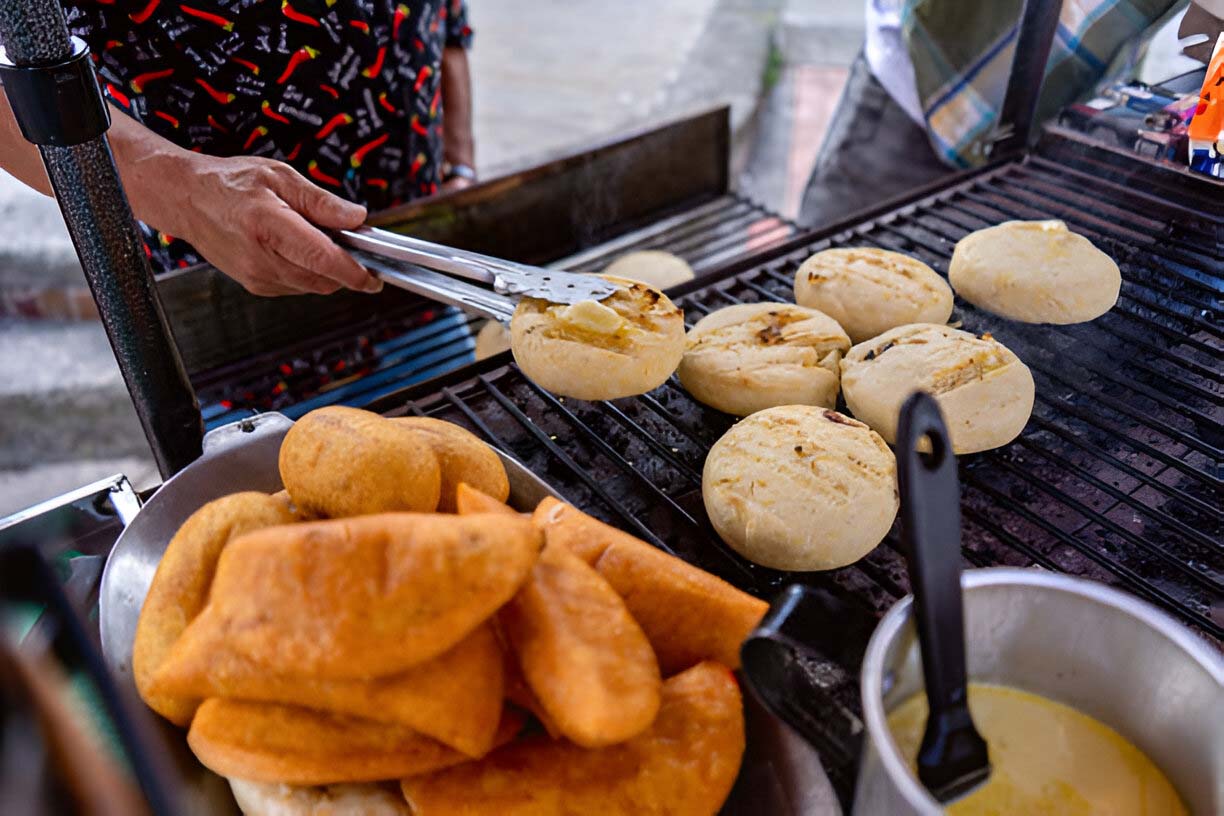
Recommendations for Must-Try Local Delicacies During Your Trip
Exploring Colombia offers a delightful culinary journey. Here are some local delicacies you shouldn’t miss along the way:
Arepas: These versatile corn cakes are a staple of Colombian cuisine, served with cheese, eggs, or meats.
Bandeja Paisa: A hearty platter featuring rice, beans, ground meat, plantain, avocado, and a fried egg.
Sancocho: A traditional soup made with chicken, potatoes, yuca, and plantains, simmered to perfection.
Empanadas: Fried pastries filled with beef, chicken, or cheese, perfect for a quick and satisfying snack.
Ceviche: Fresh seafood marinated in lime juice with onions, tomatoes, and cilantro, a refreshing coastal favorite.
Patacones: Fried green plantains served as a side dish or snack, often topped with cheese or hogao sauce.
Ajiaco: A creamy potato and chicken soup, flavored with corn and herbs, a specialty of Bogotá but found in Medellín too.
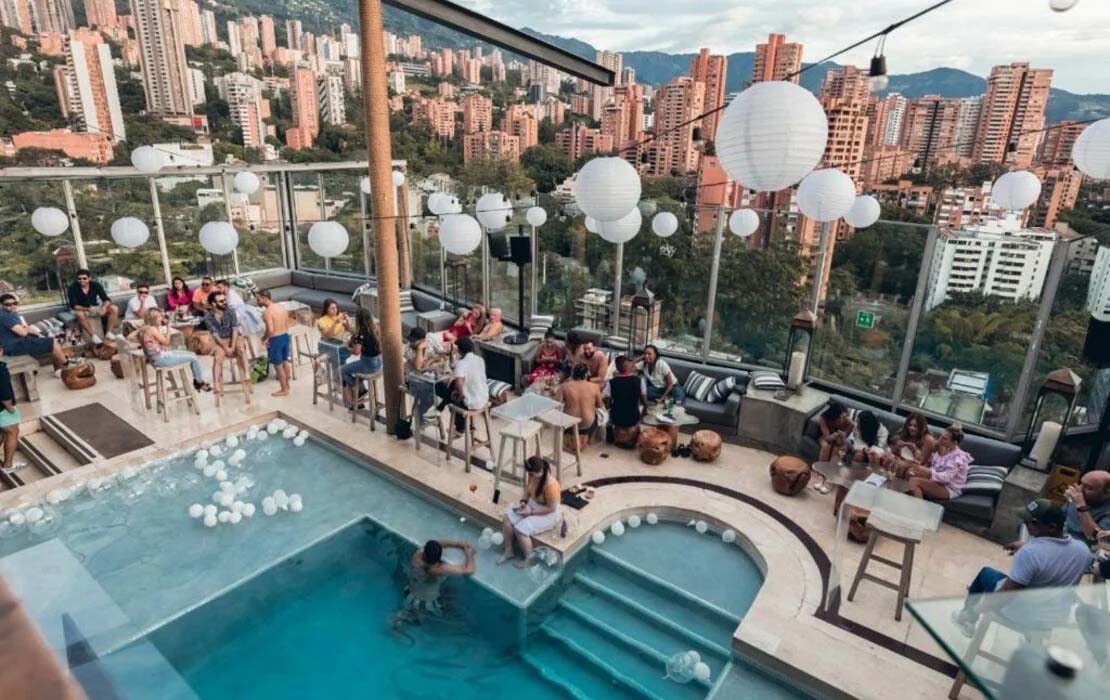
Top-Rated Places to Stay in Medellín Colombia
Medellín offers a diverse range of accommodations to suit every traveler’s preferences and budget. Neighborhoods like El Poblado and Laureles have many restaurants offering diverse dining experiences. Whether you’re seeking budget-friendly options or indulgent luxury, here are some top-rated places to consider:
Budget Hostels
Black Sheep Hostel Medellín: Located in the heart of El Poblado, known for its social atmosphere and affordable rates.
Hostal Rango Boutique: A cozy hostel in Laureles with clean rooms and a relaxed ambiance, ideal for budget-conscious travelers.
Mid-Range Hotels
Hotel Park 10: Situated in the upscale El Poblado neighborhood, featuring comfortable rooms, a rooftop pool, and excellent service.
Diez Hotel Categoria Colombia: Located in El Poblado, offering modern amenities and a stylish ambiance.
Luxury Hotels
The Charlee Hotel: A boutique hotel in El Poblado, known for its luxurious rooms, rooftop bar with stunning city views, and vibrant nightlife.
Hotel Medellín Royal: Set in a historic building in El Poblado, offering elegant rooms, a spa, and gourmet dining options.
Medellín’s accommodations cater to diverse tastes, whether you prefer the bustling nightlife of El Poblado, the local charm of Laureles, or the tranquility of Envigado and Sabaneta. Many now cater to the needs of digital nomads and other expats, with staff that can speak English and have a unique perspective on their home country.
Whichever you choose, these top-rated options promise comfort, convenience, and a memorable stay in Colombia’s City of Eternal Spring.
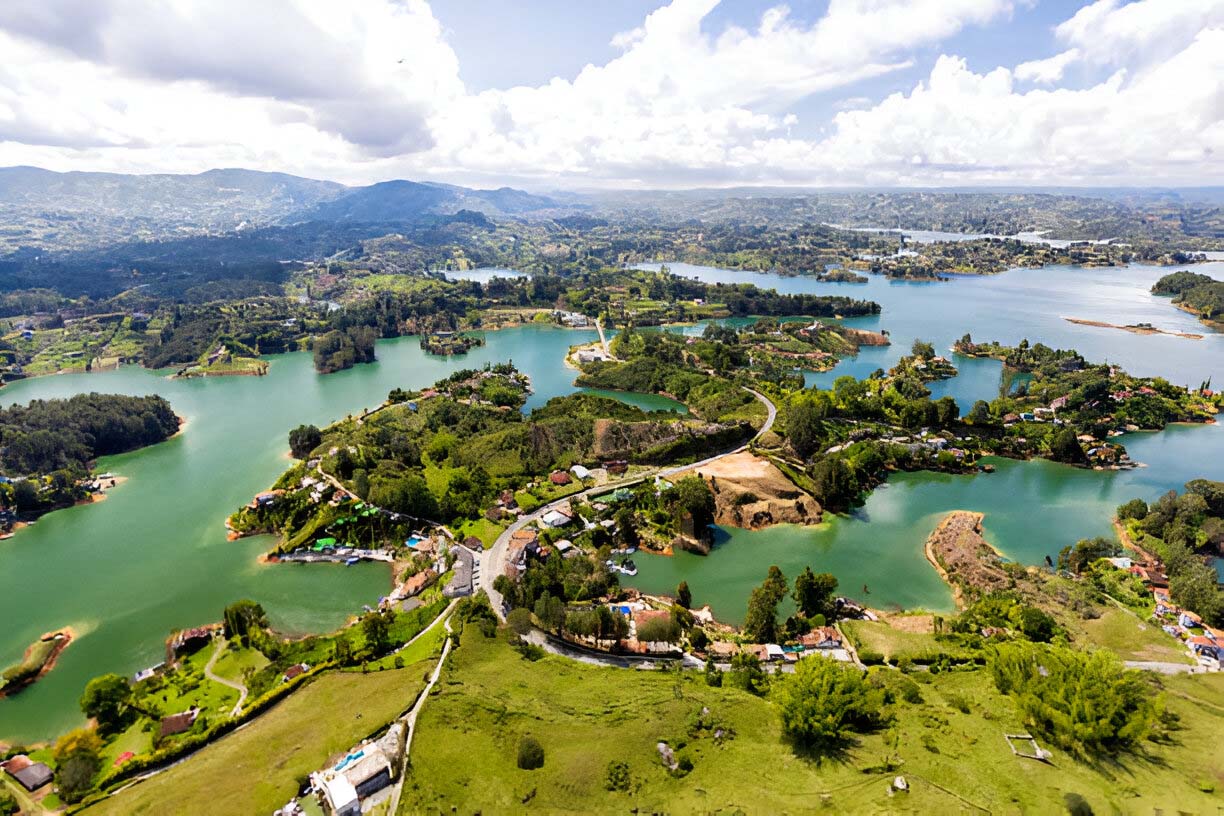
Day Trips from Medellin: Explore the Surrounding Areas
Venturing beyond Medellín allows you to discover the diverse landscapes and cultural treasures of Antioquia. From coffee farms to natural parks, here are some captivating day trip destinations to consider:
Guatapé: Known for its stunning rock formation, El Peñol, which offers panoramic views from its summit, including the entire city and surrounding areas. Explore the colorful streets adorned with intricate zocalos (decorative tiles) and enjoy water activities on the nearby reservoir.
Santa Fe de Antioquia: A colonial town boasting well-preserved architecture and cobblestone streets. Visit the Puente de Occidente, a historic suspension bridge, and relax by the Cauca River.
Jardín: A picturesque town renowned for its coffee culture and lush green landscapes. Take a stroll in the main square surrounded by traditional houses adorned with balconies, and ride the cable car for breathtaking views of the countryside.
Parque Arví: A natural reserve located just outside Medellín, offering hiking trails, eco-tours, and cultural activities. Immerse yourself in the region’s biodiversity and indigenous heritage.
Piedra del Peñol: Another prominent rock formation near Guatapé, featuring a staircase leading to a viewing platform with spectacular vistas of the surrounding lakes and islands.
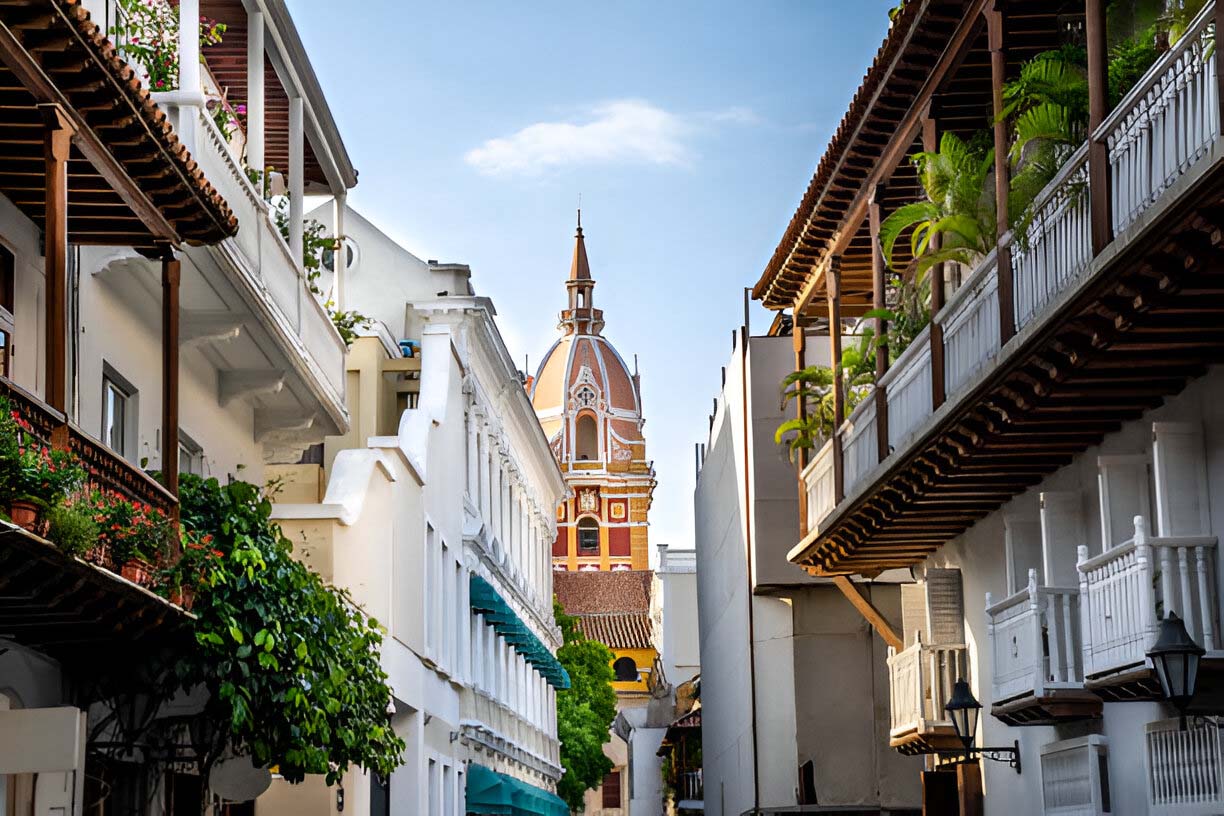
Final Tips for Your Journey
Traveling between these two cities offers a fascinating exploration of Colombia’s diverse landscapes, vibrant cities, and rich cultural heritage.
If you’re drawn to Cartagena’s colonial charm and Caribbean vibes or Medellín’s modernity and mountainous surroundings, this journey promises unforgettable experiences. Medellín’s EnCicla bike sharing system won the 2012 Sustainable Transport Award along with San Francisco, highlighting its commitment to sustainable transport.
Here’s a detailed guide to help you plan and make the most of your trip:
Transportation Options
Flights vs. Buses
Flights: The fastest way to travel between Cartagena and Medellín, taking approximately 1-1.5 hours. Several airlines operate daily flights, offering convenience and saving time.
Buses: A more budget-friendly option with various classes available, including executive and luxury buses. The journey takes around 12-13 hours, offering scenic views along the way.
Choosing the Right Mode of Transport
Consider your budget, time constraints, and comfort preferences when deciding between flights and buses.
Flights are ideal for those short on time or preferring a quicker journey, while buses allow you to appreciate Colombia’s countryside and save on travel costs.
Accommodation Options
Top-rated Neighborhoods in Medellín Colombia
El Poblado: Known for its nightlife, upscale dining, and proximity to major attractions like Parque Lleras.
Laureles: A more local vibe with tree-lined streets, cozy cafes, and easy access to public transportation.
Envigado and Sabaneta: Quieter suburbs offering a relaxed atmosphere, local markets, and a glimpse into everyday Colombian life.
El Centro/La Candelaria: Historic district in downtown Medellín with colonial architecture, museums, and cultural landmarks, though safety considerations are important at night.
Choosing the Right Accommodation
Research and book accommodations in advance, especially during peak travel seasons.
Budget travelers can find affordable hostels and guesthouses, while luxury seekers can indulge in boutique hotels with upscale amenities.
Cultural Insights
Embracing Local Customs
Greetings: Colombians are warm and friendly; greet most people with a handshake and a smile, using formal titles like “señor” and “señora” when appropriate.
Family and Community: Respect for family is crucial; many social activities revolve around family gatherings.
Dining Etiquette: Wait until everyone is served before starting your meal; express gratitude with a sincere “gracias.”
Dress Code: Colombians take pride in their appearance; dress neatly and conservatively in most situations.
Cuisine and Nightlife
Must-Try Dishes: Sample local delicacies such as arepas, bandeja paisa, and ceviche, reflecting Colombia’s diverse culinary heritage.
Nightlife: Experience Medellín’s vibrant nightlife with salsa clubs, cocktail bars, and live music venues. Explore El Poblado for a lively atmosphere or Laureles for a more laid-back evening.
Safety and Practical Tips
Safety Considerations
— Exercise caution in crowded areas and avoid displaying valuables openly.
— Use reputable transportation services like taxis or Uber, especially at night.
— Stay informed about local news and follow any travel advisories issued for Colombia.
Money and Communication
Currency: The Colombian Peso (COP) is widely used; ATMs are accessible in major cities for cash withdrawals.
Language: Spanish is the official language; learning basic phrases can enhance your travel experience and facilitate communication with locals.
Weather and Packing Tips
Climate: Cartagena has a tropical climate with high humidity, while Medellín enjoys a temperate climate due to its elevation. Pack lightweight clothing for Cartagena and layers for cooler evenings in Medellín.
Essentials: Sunscreen, a reusable water bottle, comfortable walking shoes, and a small backpack for day trips are recommended.
Exploring Surrounding Areas
Day Trips from Medellín
Guatapé: Climb the iconic El Peñol rock for panoramic views and explore the picturesque town adorned with colorful zocalos.
Santa Fe de Antioquia: Visit this colonial gem with well-preserved architecture and relax by the Cauca River.
Jardín: Discover Colombia’s coffee culture, ride a cable car for stunning vistas, and admire the town’s traditional architecture.
Local Festivals and Events
Plan your trip around cultural events like the Medellín Flower Festival (Feria de las Flores) or local celebrations to immerse yourself in Colombian traditions and festivities.
Don’t Mention Pablo Escobar!
When visiting Medellín, it’s important to recognize the city’s incredible transformation and the vibrant culture that defines it today. Although once synonymous with Pablo Escobar and the violence of the drug trade, Medellín has undergone a remarkable metamorphosis, focusing on innovation, art, and community-driven projects.
Medellín has invested heavily in urban renewal and public transportation, making it a model of progress in Latin America. The city’s Metro system, along with its unique cable cars, connects diverse neighborhoods and provides stunning views of the surrounding Andes. Innovative public spaces like the Explora Park and the Biblioteca España have been designed to enrich the community and foster a sense of pride among locals.
Beyond its infrastructure, Medellín is a cultural hub, showcasing a lively arts scene and a deep appreciation for creativity. The city is home to numerous galleries and museums, such as the Medellín Museum of Modern Art and the Museo de Antioquia, which features works by the renowned Colombian artist Fernando Botero. Medellín’s bustling areas, such as El Poblado and Laureles, offer an array of trendy bars, cafes, and restaurants where you can experience the city’s dynamic culinary scene.
By focusing on its strengths and moving beyond its past, Medellín has redefined itself as a symbol of resilience and innovation. As you explore this vibrant city, you’ll discover a community that embraces its rich cultural heritage while looking forward to a brighter future.
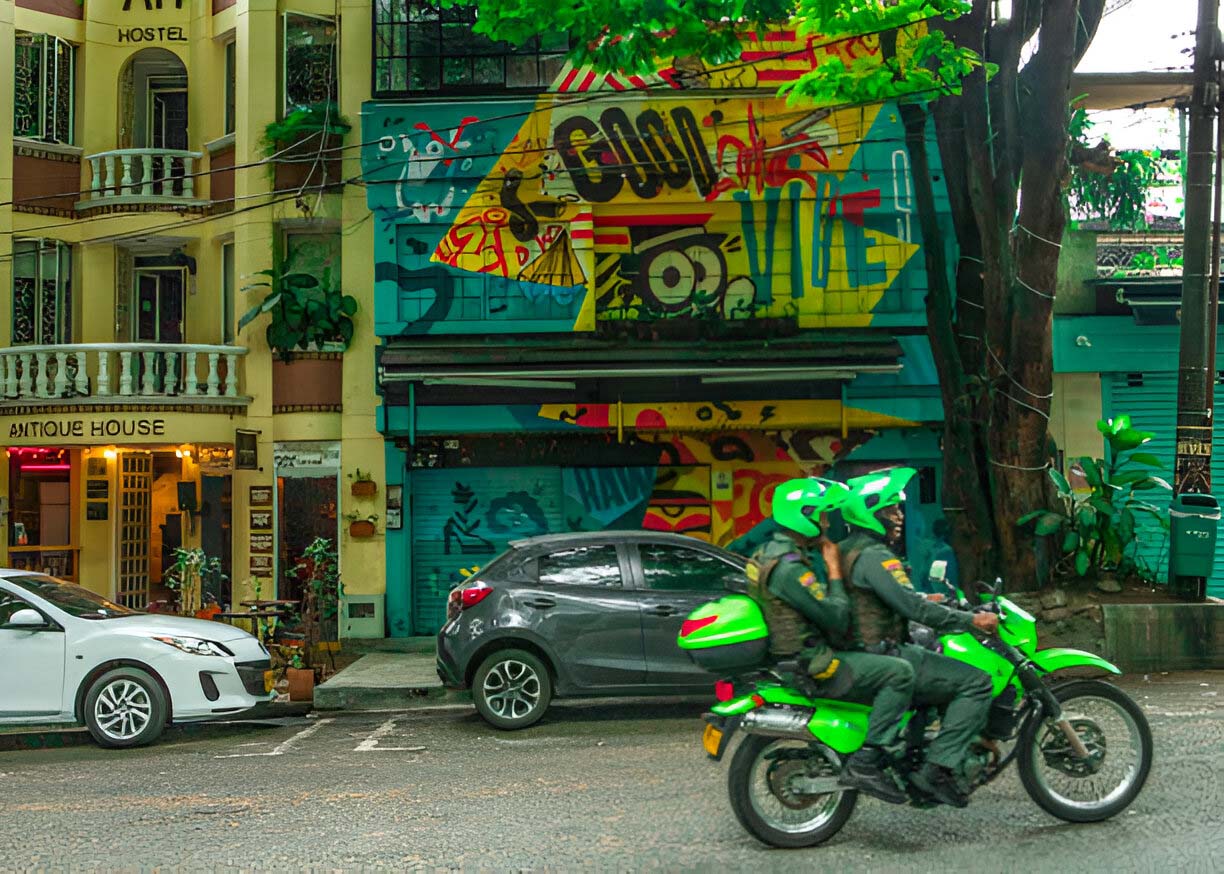
Conclusion
Traveling from Cartagena to Medellín is more than just a geographical journey; it’s an immersive experience into Colombia’s rich tapestry of history, culture, and natural beauty. Cartagena, with its UNESCO World Heritage-listed old town and Caribbean allure, introduces you to the country’s colonial past and vibrant coastal traditions.
The city’s colorful streets, lively music, and diverse cuisine embody centuries of Spanish, African, and indigenous influences, creating a dynamic cultural mosaic that captivates visitors from around the globe.
As you venture inland to Medellín, nestled in the Aburrá Valley amidst the Andes Mountains, you’ll witness Colombia’s transformation into a modern metropolis known for its innovation and resilience.
Medellín’s scenic landscapes, temperate climate, and flourishing arts scene reflect the city’s journey from a tumultuous history to a beacon of progress and opportunity. Here, you can explore dynamic spots like El Poblado, with its bustling nightlife and upscale dining, or discover the authentic charm of Laureles and its local markets and cafes.
Throughout your journey, embracing local customs—from greeting strangers with warmth and respect to savoring traditional dishes like bandeja paisa and ajiaco—connects you deeply with Colombian culture. Each encounter, whether with locals in a bustling market or during a tranquil moment in a historic plaza, offers insights into the values and traditions that shape daily life in Colombia.
Exploring the diverse landscapes surrounding Medellín—like the breathtaking views from El Peñol in Guatapé or the serene coffee plantations in Jardín—immerses you in Colombia’s natural beauty and agricultural heritage. These day trips not only offer picturesque vistas but also opportunities to engage with local communities and learn about their way of life.
In conclusion, whether you’re drawn to Cartagena’s coastal allure or Medellín’s mountainous charm, your journey through Colombia promises to be a transformative experience. By delving into the country’s past and present, indulging in its culinary delights, and exploring its varied landscapes, you’ll create memories that resonate long after your return home.
This guide equips you with essential information to navigate your travels seamlessly, ensuring a rewarding and enriching exploration of Colombia’s vibrant culture and hospitality. Embrace every moment, savor every flavor, and immerse yourself fully in the magic of Colombia. Safe travels!
